
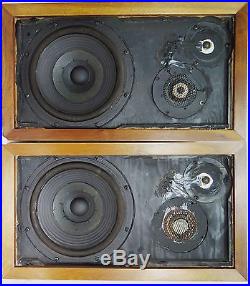
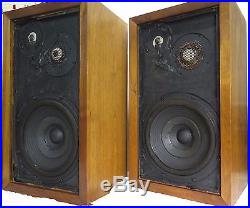
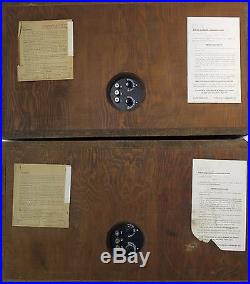
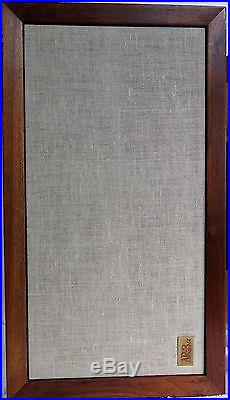

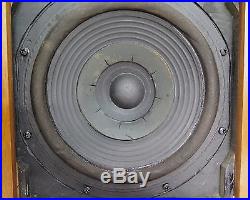

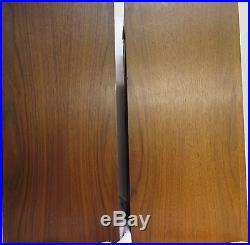


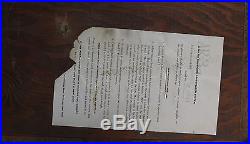

Acoustic Research AR-3a Loudspeaker Pair, Oiled-Walnut Cabinets, SN 12821 & 12823, 1968, Excellent Original Condition. This pair of speakers was ordered in conjunction with an AR Amplifier and AR Turntable, updating my high-fidelity system. The AR-3as were used periodically after that date, but primarily remained stored. These AR-3a speakers are highly collectible and in excellent, original condition, both physically and electro-mechanically. The likelihood of finding a pair of 48-year-old AR-3a speakers in this condition is remote at best; most speakers of this type were used extensively for many years, and unfortunately, the cabinets, drivers and components tend to suffer over time accordingly. Also noteworthy is that the original versions of the AR-3a are the most collectible and the most. Desirable versions of the AR-3a built over time. There are no issues, and the all drivers work fine. There is some minimal oxidation of the level controls, but the oxidation is light because of the dry storage over time. These speakers have always been in a low-humidity setting for use or storage. They were recently tested and perform well. The woofers have a perfect “acoustic” seal, and the surrounds are like brand-new. Both midrange and high-frequency drivers work fine. The beige-linen grills are excellent with minimal deterioration or “dust” lines or fading, and the brass logos are in very good condition. The oiled-walnut cabinets are nearly flawless without any scratches, nicks, or marks. The cabinets on these speakers were finished in oiled-walnut finish and waxed. The early oil finishes were smooth and lustrous, the wax final coating gave a smooth appearance. Having been stored for many years, the walnut has not darkened particularly. These speakers were last briefly used by this owner in the late 1990s, and have been stored in air-conditioned storage since that time. Over the 48-year history of these remarkable loudspeakers, the total time of actual use was a few years in the late 1960s and the early 1970s and one year in 1998. The rest of the time these have been in storage. It should be noted that all of the 4-ohm 1. Inch midrange drivers used in the various iterations of the AR-3a and early AR-11s and AR-10s (before Ferrofluid in 1977) are electrically identical, but there are some slight cosmetic differences in the top plate. This speaker was run through a complete battery of tests at the AR plant and passed all tests. AR-3a History, Performance and Physical Description. The AR-3a is a 3-way, full-range, 4-ohm acoustic-suspension loudspeakertechnically a bookshelf speaker for very sturdy bookshelveswhich. Includes the well-known AR 12-inch acoustic-suspension woofer and 1-1/2-inch dome midrange and 3/4-inch dome tweeter drivers, based on the original AR-3. The AR-3a was primarily designed primarily by Roy Allison and. Chuck McShane of Acoustic Research, Inc. And the speaker was introduced at the New York High Fidelity Music Show in October, 1967. The result was a speaker with the widest dispersion of any forward-facing loudspeaker ever designed until the Allison: One was introduced in mid-1970s. The question of whether the AR-3a was superior or more accurate than the AR-3 has always been asked, and in many ways. Speaker can outpoint the other; however, the AR-3a was an improvement in off-axis dispersion of all of the drivers by the new lower woofer crossover and the smaller dome tweeters used. The acoustically sealed, heavily braced (nine internal braces screwed and glued to the inside of the cabinet) and properly damped (the “Q” of the AR-3a is 0.9 – 1.0) AR-3a enclosure volume is 1.7 cu. Which is optimal for the 41-43 Hz resonance frequency, and the woofer’s suspension restoring force ratio is approximately 85% acoustic and 15% mechanical, far greater than nearly all current consumer loudspeakers using the acoustic-suspension design. For this reasonand the basic design of the motor system in the AR wooferthe AR-3a has. Lower harmonic distortion than any conventional, current-design loudspeaker of a comparable size. Julian Hirsch measured the woofer’s harmonic distortion at a power level. Than usual, customary test input voltages, and the distortion in the AR-3a’s woofer was under 9% at 20 Hz, setting a new standard of low distortion, especially at this high-power testing. The woofer used in this pair of AR-3a speakers has a large 9.6 lb Alnico-5 magnet assembly, cast-aluminum frame and a long-throw, 2-inch heavy-duty copper voice coil with a linear excursion of 5/8-inch and a maximum physical excursion of 1.2 inches. The midrange driver has a 1½-inch treated-cloth dome (hemispherical) diap. Gm with 1½-inch copper voice coil on an aluminum former assembly. The midrange driver is critically damped with fiberglass pads under and above the dome assembly itself. The magnet assembly is a large ferrite unit. The AR-3a tweeter uses a ¾-inch treated-paper dome diap. Gmsimilar to the original AR-3 phenolic-dome tweetersuspended. By urethane-polymer foam pieces in the outside portion of the voice coil with a layer of clear butyl-rubber sealing the outside of the magnetic gap. The magnet assembly is ferrite. The drivers have LCR crossover frequencies of 575 Hz and 5,000 Hz. The speaker’s impedance ranges from 2.7 4.9 ohms, and the speaker is approximately 0.5-0.7% efficient, meaning that an amplifier capable of at least 30-50 watts-per-channel into 4 ohms is the. The AR-3a physical dimensions are 14 x 25 x 11-3/8. The AR-3as net weight, each, unboxed, is 54 lbs. Overall Description covered by. Reproduction or copying of any of this material without the express permission of the writer is unlawful and prohibited. High Point, NC USA. Vietnam (Ho chi Minh). Additional Tests on these AR-3a loudspeakers, SN 12821 and 12823. I did another lengthy test on both AR-3a speakers on November 20, 2016, and the speakers performed beautifully. I did both low-power frequency sweeps (1W or less) and varied music tests. Actually, the level controls are not particularly oxidized — as one might expect — most likely due to very dry storage conditions and low total hours of use for these two speakers. All woofers, mid-range drivers and tweeters worked well, and the speakers really haven’t changed much from earlier usage. Also, the woofers are perfectly acoustically sealed, meaning that they return slowly when the cone is carefully depressed inward, and this is a very important characteristic of the properly working woofers. Both midrange drivers sound exactly alike with excellent output, and the tweeters are both surprisingly good with probably 3-5 dB lower output than the midrange, but this is exactly the way the speakers were designed originally. I don’t think there would be any reason for anyone to venture inside these very original speakers to modify them in any way. The level controls definitely work well across a wide range of travel even with some very slight dropouts here and there, but it would not be worthwhile to disassemble the speakers and upset the acoustic seal, etc. The controls can be rotated back and forth periodically to “clean” the contact surfaces, and that is all that would be needed. The item “Acoustic Research AR-3a Loudspeaker Pr, Oiled-Walnut SN 12821 & 12823, Ex-Cond” is in sale since Tuesday, November 22, 2016. This item is in the category “Consumer Electronics\Vintage Electronics\Vintage Audio & Video\Vintage Speakers”. The seller is “acoustic-research-inc” and is located in High Point, North Carolina. This item can be shipped worldwide.
- Brand: Acoustic Research (“AR”)
- MPN: AR-3a
- Model: Acoustic Research AR-3a
- Country/Region of Manufacture: United States
